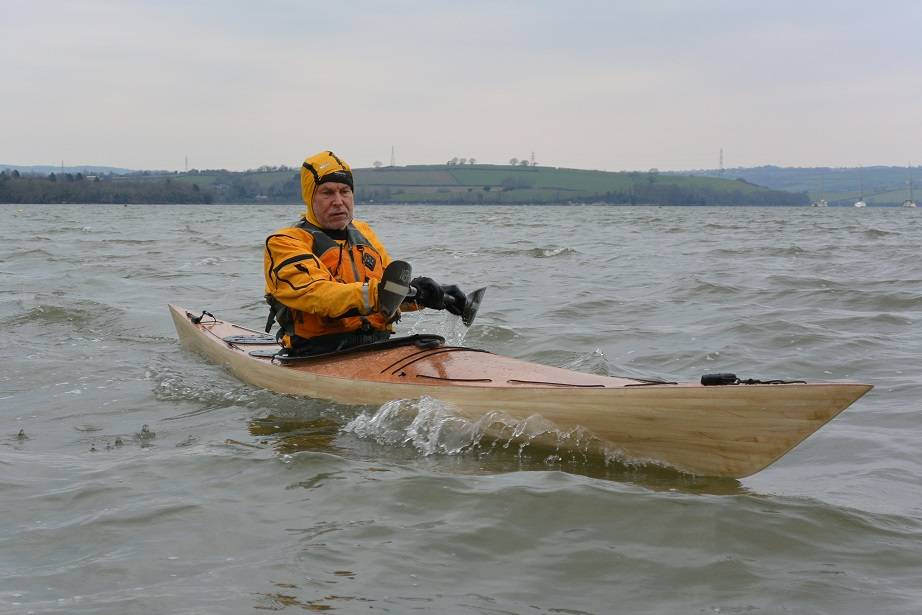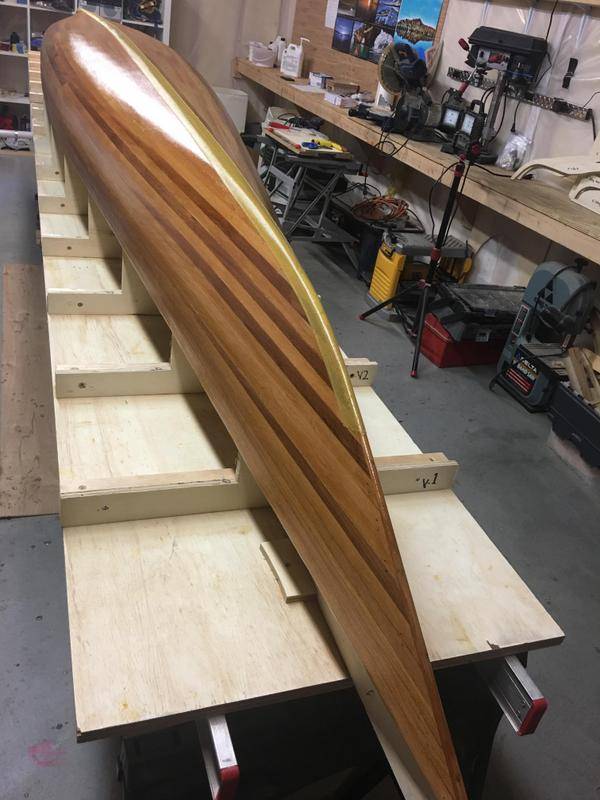We’ve just launched Vember, a new family of self-build sea kayak designs. Vember combines a simplified round-bilge strip-built hull with the plywood deck from our Shrike design. This avoids many of the complexities of round-bilge construction which have always stopped me from attempting this. Free plans and a 59 page Build Manual are downloadable at no cost in a variety of formats, from letter/A4 size to the data files to drive a CNC printer.
Vember is a customizable lightweight family of sea kayak designs for rough water, with progressive and reassuring stability. You can vary many of the dimensions of the design to suit your purposes. Vember weighs 32 pounds, with hatches, skeg system and knee tube. (I recall Pikabike from this forum stating a preference for round bilge hulls, and searching for the ideal kayak. That was in my mind when I worked for 18 months developing and testing this design.)
Anyone is free to adapt the design and to make money from supplying kits or completed kayaks.
Nick, of www.cnckayaks.com
…and for those ‘boat building’ challenged (talent, skills, time, space, desire), ‘ClearStream’ built a Shrike-R for me at a reasonable price.
‘just getting home’ pictures a couple of years ago:
shriker_1 shriker_2 shriker_3 shriker_4
Raisins, I’m guessing your Shrike-R is the 26 pound beauty in our Gallery here: http://cnckayaks.com/2015/01/26/clear-stream-custom-water-craft-shrike-r/
I hope she’s given you a lot of pleasure, and many thanks for your post…
In the past three years 120 builders have been kind enough to send me details of their Shrikes.
Happy paddling!
Nick
Uh oh, I feel a little guilty. And I am soooo done for now, because this is the first boat that has caught my eye since I bought the Pilgrim Expedition more than 7 years ago!
Thirty-two pounds would be a huge weight reduction. Is that for fully-glassed inside and out?
We are in the throes of having a new home built, so nothing’s gonna happen, boatwise, for a while. But there will be a terrific place in the garage, designed for a possible future workshop.
What makes this one special?
Pikabike, yes, fully glassed inside and out, with hatch lids and deck lines fitted, 3D printed deck fittings and a knee tube for a manual pump. I did design Vember with you in mind after you said you preferred round bilge hulls for their performance, but I have ten lightweight granddaughters and a paddling wife, all of whom deserve lightweight kayaks. I owned the first Vember for just one week. My wife paddled her, and stated that it was hers. She absolutely loves its performance and light weight. We immediately sold her heavy glass fibre “LV” . On Monday we fly from the UK to Minneapolis to visit our son, and we plan to build a Vember for his wife, who is about your size and weight. (100 pounds, I guess) If you wanted to replicate your Pilgrim Expedition you can reduce Vember’s beam and lengthen her to the same dimensions. The Build Manual enables this very simply. However, Vember would be nearly half the weight 
I’ve attached a photo of a Vember Expedition, which is the same length as the Pilgrim Expedition.
Best wishes, from Nick.
I’ve built them in Pawlonia, a difficult timber to obtain in the USA, I believe. In the USA I have built a Vember Expedition using cedar, 3/16th inch thick strips sawn from 3/4 inch planks. There is no need for the strips to be shaped as “cove and bead”.
Beautiful. And 38 lbs is still wondrously light for a 17’ kayak.
@string said:
What makes this one special?
String:
The free plans enable you to select the length of the Vember, and her beam, independently of each other. One changes the length by changing the spacing of the forms, and one changes the beam by selecting the scale to print the plans of the forms. This is only possible as one downloads the plans in digital format, and hence they are printable in any scale. That freely donates to the world the benefit of hundreds of hours of my work and my 60 years experience of boat-building. You are also free to build and sell kits or completed kayaks without payment of royalty. That’s the design equivalent of “giving away the farm”.
The builder can choose to construct a long skinny kayak or a short fat one, and anything in-between. Plus or minus 10% would be a safe range to adjust either dimension, and an appendix in the Build Manual gives tables to facilitate this. Everything about the project is designed to simplify the construction.
So Vember is a whole family of kayaks, and you can design your own. I don’t design using a computer. Using a computer design system can be a very quick way of producing a very bad kayak. I build a prototype by eye and experience in the traditional way, and then measure the kayak (that’s a week’s work) to reproduce the shapes on computer software (QCad) to enable us to give the design to the world.
Oh, and yeh, ain’t she purdy? 
Nick.
SO purdy.
Other aspects which may be of interest are that you can choose the shape and size of the cockpit, the freeboard (height of gunwales, and hence windage), knee clearance at the front of the cockpit, and hatch layout.
Nick
@nickcrowhurst said:
@string said:
What makes this one special?String:
The free plans enable you to select the length of the Vember, and her beam, independently of each other. One changes the length by changing the spacing of the forms, and one changes the beam by selecting the scale to print the plans of the forms. This is only possible as one downloads the plans in digital format, and hence they are printable in any scale. That freely donates to the world the benefit of hundreds of hours of my work and my 60 years experience of boat-building. You are also free to build and sell kits or completed kayaks without payment of royalty. That’s the design equivalent of “giving away the farm”.
The builder can choose to construct a long skinny kayak or a short fat one, and anything in-between. Plus or minus 10% would be a safe range to adjust either dimension, and an appendix in the Build Manual gives tables to facilitate this. Everything about the project is designed to simplify the construction.
So Vember is a whole family of kayaks, and you can design your own. I don’t design using a computer. Using a computer design system can be a very quick way of producing a very bad kayak. I build a prototype by eye and experience in the traditional way, and then measure the kayak (that’s a week’s work) to reproduce the shapes on computer software (QCad) to enable us to give the design to the world.
Oh, and yeh, ain’t she purdy?
Nick.
She is beautiful! Thanks.
That’s the first hybrid I’ve seen with both plywood and strips. Perhaps there are others I’m not aware of, but it never crossed my mind before.
Neat.
This procedure avoids the need for assembling forms which include both the hull and deck, and sliding these along a beam, which is the standard procedure, That’s too complicated, time-consuming and error-prone for my liking, The aim of Vember is to provide an elegant round-bilge hull with the simplest possible procedure.
Nick.




